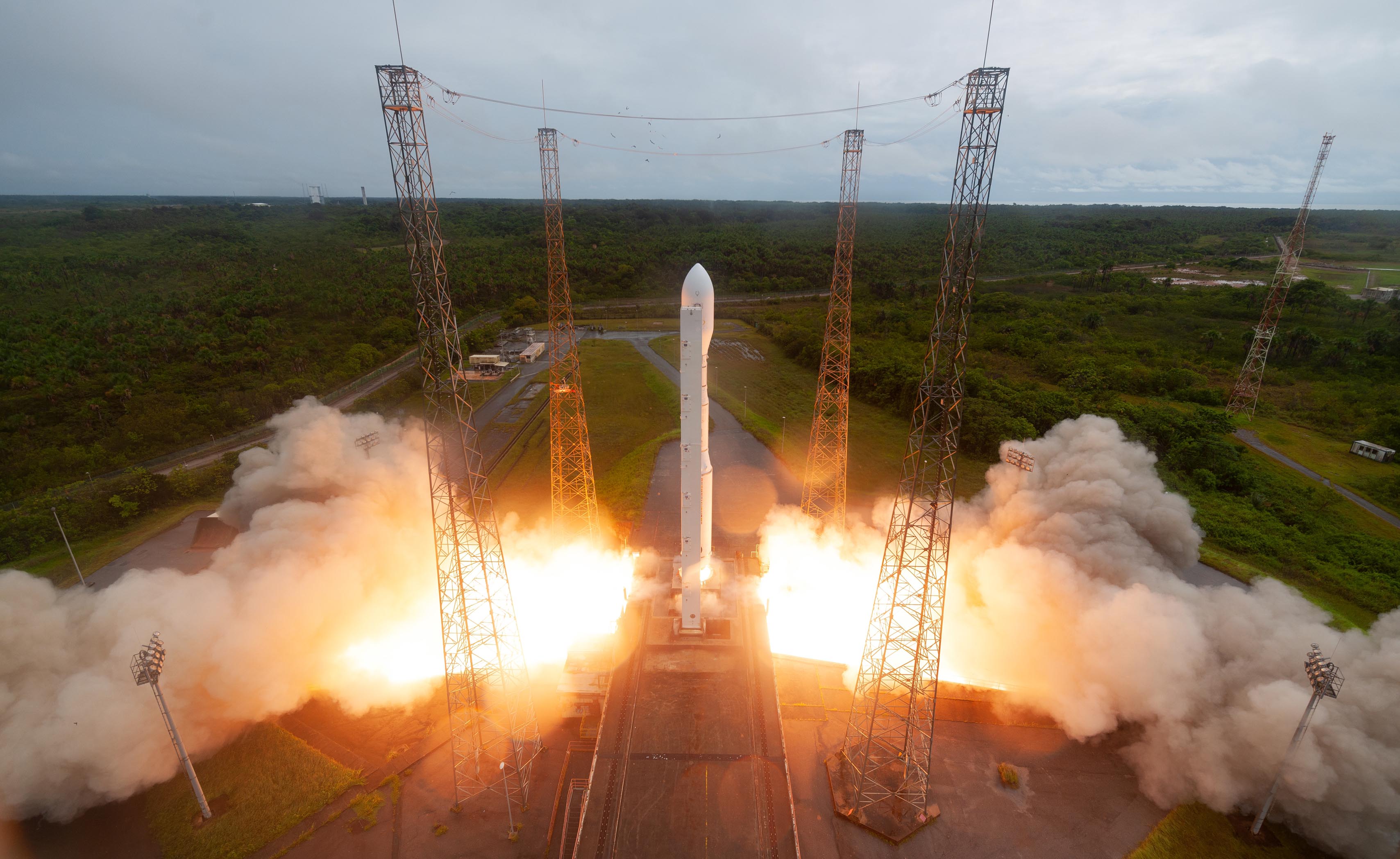The excitement of Europe’s successful inaugural launch of its all-new Vega C rocket was infectious at the launch site in French Guiana this week (Wednesday, 13 July) as the countdown went into two technical holds during the two-hour window.
In a post-launch press briefing there was a tangible sense of relief that the first launch had gone without a hitch, putting Europe on the road to a new generation of rockets which will deliver low cost and flexible access to space.
“As is normal for a maiden flight there was high level of pre-launch tension,” said ESA Director of Space Transportation Daniel Neuenschwander. “Everything was new on the rocket and so we knew there was potential for a number of things to go wrong.”
In the event, flight VV21 eventually lifted off smoothly from Europe's Spaceport in French Guiana at 10:13 Kourou local time (15:13 CEST) on a mission lasting two hours and 15 minutes from launch to release of the final payload and final burn of the AVUM+ upper stage engine.
The rocket’s total payload mass at liftoff was approximately 474 kg, comprising 296 kg for the LARES-2 satellite, with the remainder accounted for by six European research CubeSats, payload adapters and carrying structures.
Vega-C represents a dramatic capability boost compared to Europe’s Vega rocket, which has flown since 2012. With new first and second stages and an up-rated fourth stage, Vega-C increases performance from 1.5 tonnes to about 2.3 tonnes in a reference 700 km polar orbit.
"Today we opened a new era of European launch solutions, starting with Vega-C and soon to be complemented by Ariane 6,” stated Neuenschwander.
Vega-C features a new, more powerful first stage, P120C, based on Vega's P80. Atop that is a new second stage, Zefiro-40, and then the same Zefiro-9 third stage as used on Vega. With its larger main stages and bigger fairing - which doubles the payload volume compared to Vega - Vega-C measures 34.8 m high, nearly 5 m taller than Vega.
The re-ignitable upper stage (AVUM+) is also improved with increased liquid propellant capacity, to deliver payloads to multiple orbits depending on mission requirements and to allow for longer operational time in space, to enable extended missions.
The P120C motor will do double service, with either two or four units acting as strap-on boosters for Ariane 6. Sharing key elements like this streamlines industrial efficiency and improves cost-effectiveness of both launchers.
Vega-C delivers a significant improvement in launch system flexibility for Europe. It can orbit larger satellites, two main payloads or accommodate various arrangements for ride-share missions. ESA's upcoming Space Rider return-to-Earth vehicle will also be launched to orbit on a Vega-C.
Vega-C also is also a timely arrival in support Europe's continued access to space as it will fill a big gap in capability now that Russian rockets are no longer available because of the war in Ukraine. The withdrawal of Russia’s Soyuz launchers from the market earlier this year left European institutional and commercial satellites scrambling for alternative rides and Vega-C will be the obvious option for many.
Neuenschwander added: “ In 2014, ESA decided to develop a new family of launchers in order to refine our access to space - Vega-C and Ariane 6 will cover all the missions required by Europe, as well as lowering the cost of access to space.
“Vega-C doubles the performance of Vega at more or less the same cost and also addresses specific market needs, particularly in relation to EO satellites,” he added. “In 2026 a new derivative, Vega-E, will provide a simplified architecture by replacing both the Vega-C third and fourth stages with a new cryogenic upper stage.”
Key to Vega-E will be the Europe-built M10 engine using more environmentally sustainable propellants - cryogenic liquid oxygen and methane - and featuring an advanced pressure control system that enables multiple stops and restarts in space.
Stephane Israel, CEO of Arianespace, said there would be two more Vega launches before reverting to Vega-C. “We have already sold seven missions, four institutional and three commercial, and we hope to soon have four more orders for the Copernicus programme from the European Commission.
“Today we have demonstrated the Vega-C is a flight proven launcher and one which is perfectly adapted to future European needs.”
The Italian Space Agency’s LARES-2 (Laser Relativity Satellite 2) is a 36.4 cm diameter passive sphere with laser mirrors for the study of Earth’s gravitational field. Its main objectives are to facilitate measurements of gravitational and fundamental physics, and accurate determinations in space geodesy and geodynamics. Scientists hope to achieve accurate testing of “frame-dragging,” an intriguing phenomenon predicted by Einstein’s theory of general relativity.
Europe's Vega-C rocket makes successful debut flight











